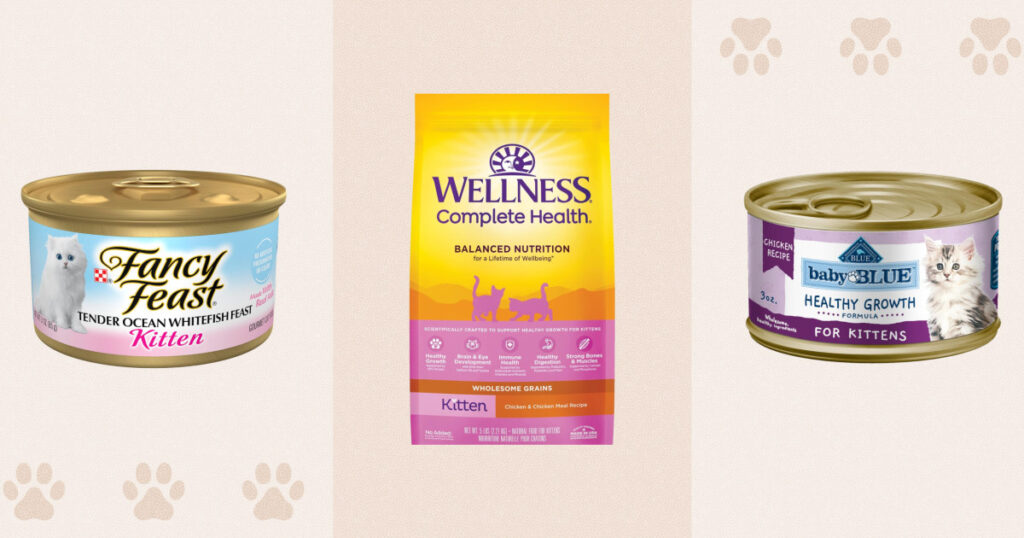Ensuring your kitten grows into a healthy adult cat starts with deciding what to feed them. The best kitten food supports their development throughout their first year of life and makes them look forward to mealtime. But with dozens of options on the market, how do pet parents decide what dry and wet food to buy? We talked to veterinarians about choosing the best kitten food, including options from Purina, Fancy Feast and Hill’s Science Diet. Experts also shared insights about how much and how often to feed your kitten, plus when to transition them to adult cat food.
Skip ahead Best dry kitten food | Best wet kitten food | How should I feed my kitten?
How we picked the best kitten food
While shopping for kitten food, veterinarians recommend thinking about the following factors.
AAFCO nutrition standards: Ensure you buy kitten food that meets AAFCO nutrition standards. You can determine this by looking at the nutritional adequacy statement printed on the label. It should note that the food is either “complete and balanced for growth” or “complete and balanced for all life stages.” This ensures that the food you buy is formulated to address kittens’ nutritional needs and has been tested for efficacy and safety.Ingredients: On a food label, ingredients are listed by weight from highest to lowest, which means the first three are the most important to consider, according to the AAFCO. Look for meat (including fish) as the first ingredient in your kitten’s food, and make sure it contains some source of DHA, an omega-3 fatty acid, like fish oil, says Dr. John Loftus, an assistant professor of small animal internal medicine and nutrition at Cornell University College of Veterinary Science. Kitten food should also have appropriate levels of nutrients like calcium, phosphorus, vitamin E, taurine (an amino acid) and fiber, says Dr. Hannah Hart, a veterinarian at Chewy.Food type: You’ll see wet and dry food while shopping, and cats of all ages should eat both daily if possible, says Dr. Abel Gonzalez, a veterinarian and the clinical director at a Dutch pet telehealth company. Wet food is high in water content and helps with hydration, while dry food is crunchy and supports kittens’ dental health.Availability: Kittens sometimes eat up to four times a day, so you’ll need a constant supply of food at home. Can you get it at a store in a pinch, or is it only available online? And if it’s only available online, how long does delivery from your preferred retailer typically take? Kittens can get an upset stomach if you suddenly change their food, so make sure you always have access to whatever you feed them. Some retailers offer cat food subscription services if you want to set up scheduled deliveries regularly.Price: Experts told us that the price of kitten food does not always correlate with quality. Focus on finding one within your budget that your kitten enjoys eating, meets AAFCO nutrition standards and is made with healthy ingredients.
The best kitten food in 2024
The food we recommend below is specifically formulated for kittens, meets AAFCO nutrition standards and has a meat source as the first ingredient, per expert recommendations. We included kitten food NBC Select pet parents recommend and highly rated options.
The best dry kitten food
Best overall: Iams ProActive Health Kitten Dry Cat Food

What we like
Small kibble sizeFiller-freeVitamin E
Iams’ kibble is small in size, so it’s easy for kittens to chew. It’s made without fillers, artificial flavors or artificial preservatives. It contains nutrients similar to those in kittens’ mother’s milk, like vitamin E, which supports the immune system. The food also has omega-3 DHA, as well as fiber and prebiotics for healthy digestion.
Size: 3.5 lb., 7 lb. or 16 lb. bag | First ingredient: Chicken | Other flavors: None
Best for digestive health: Purina Pro Plan Kitten Shredded Blend Chicken & Rice Formula Dry Cat Food
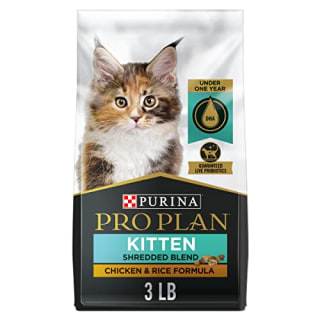
What we like
Two-texture formulaProbioticsAntioxidants
Purina’s Pro Plan line offers some of our favorite cat food, and this specific formula is made for growing kittens. It’s a mix of crunchy kibble and shredded, meaty chicken pieces. In addition to essential nutrients like DHA, calcium and phosphorus, the dry food contains probiotics to support kittens’ digestive health and antioxidants to help them develop immune systems.
Size: 3 lb., 5lb. or 12 lb. bag | First ingredient: Chicken | Other flavors: None
Best natural kitten food: Hill’s Science Diet Kitten Healthy Development Chicken Recipe Dry Cat Food
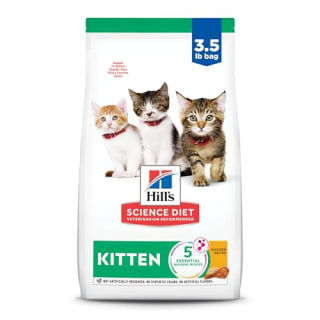
What we like
Two flavors availableSmall kibble sizePrebiotics
Something to note
Nothing to note at this time
Hill’s Science Diet’s dry kitten food is made with all-natural ingredients, and it’s free from chicken by-product meal, artificial flavors, synthetic colors and artificial preservatives. The kibble is small and pellet-shaped, making it easy for kittens to chew. It’s formulated with DHA from fish oil, an antioxidant blend of vitamins C and E to support the immune system, and prebiotics to support the gut microbiome and digestive system. You can also purchase a version of this dry kitten food that does not contain corn, wheat or soy if your cat is sensitive to those ingredients.
Size: 3.5 lb., 7 lb. and 15.5 lb. bag | First ingredient: Chicken | Other flavors: Seafood
Best grain-free: Merrick Purrfect Bistro Grain-Free Healthy Kitten Recipe Dry Food
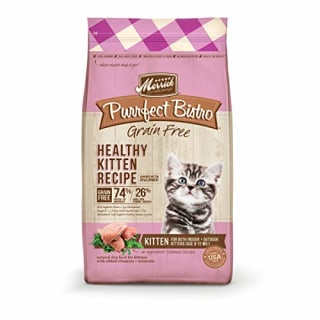
What we like
Grain-freeSmall kibble sizeOmega-6 & omega-3 fatty acids
I fed my cat Wanda Merrick’s grain-free kitten food when I first adopted her at two months old. She only had a few teeth since she was young, but she happily ate this small, pellet-shaped kibble. The dry food has natural ingredients like deboned chicken, salmon oil, potatoes, and cranberries. It has probiotics that support digestion, antioxidants that support the immune system and omega-6 and omega-3 fatty acids that support the skin and fur. The dry food is made without artificial colors, flavors or preservatives.
Size: 4 lb. or 7 lb. bag | First ingredient: Deboned chicken | Other flavors: None
Editor’s pick: Wellness Complete Health Natural Dry Kitten Food
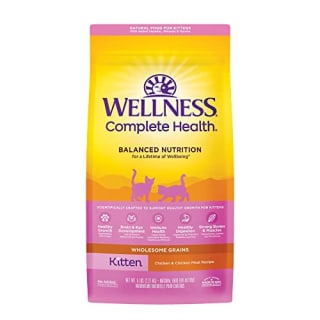
What we like
Small kibble sizePrebiotics and probioticsVitamins A, E and zinc
Something to note
One flavor availableOne size available
My cat Lucy ate Wellness Complete Health’s dry kitten food before I adopted her, so I continued feeding it to her at home. The small, pellet-shaped kibble is made with natural ingredients and does not contain meat by-products, fillers or artificial preservatives. It’s formulated with vitamins A, E and zinc to support immune health; calcium and phosphorus to support the bones and muscles; and prebiotics, probiotics and fiber to support digestive health.
Size: 5 lb. bag | First ingredient: Deboned chicken | Other flavors: None
The best wet kitten foods
Best overall: Fancy Feast Kitten Tender Ocean Whitefish Feast Canned Cat Food
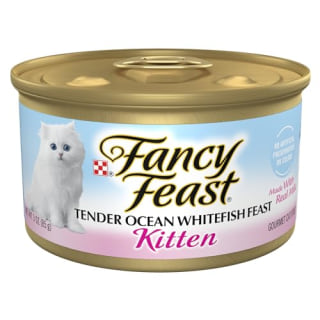
What we like
Pate textureRich in vitaminsMultiple flavors available
Both of my cats were picky about their wet food as kittens, but they always ate this Fancy Feast formula without hesitation. It’s made with real milk and vitamins like E, B-12 and D-3. The wet food has a pate texture and does not contain artificial preservatives or colors. You can purchase it in a multipack of flavors or as individual flavors.
Size: 24 3 oz. cans | First ingredient: Ocean whitefish | Other flavors: Chicken, turkey, salmon
Best grain-free: Wellness Complete Health Grain-Free Whitefish & Tuna Entrée Wet Canned Kitten Food

What we like
Grain-freeMultiple flavorsMultiple can sizes
Something to note
Nothing to note at this time
I’ve also fed my kittens Wellness Complete Health’s wet food, which is free from grains, corn, wheat and soy. It has a smooth pate texture and contains natural ingredients like carrots, pumpkin, flaxseeds and cranberries. The food’s formula has fish oil as a source of DHA and prebiotics for digestion support. You can purchase the wet kitten food in a multipack of flavors or individually.
Size: 12 or 24 3 oz. or 5.5 oz. cans | First ingredient: Whitefish | Other flavors: Chicken
Best in gravy: Royal Canin Feline Health Nutrition Thin Slices in Gravy Wet Kitten Food
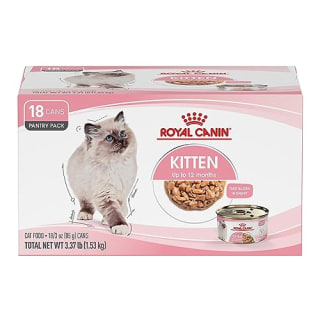
What we like
Two textures availableAntioxidantsFish oil
Royal Canin’s wet food for kittens is made from thin slices of meat in a gravy sauce, giving it a soft texture that’s easy for baby teeth to chew. The food contains antioxidants like vitamins E and C and fish oil, a source of omega-3 fatty acids. You can also purchase the food as a pate loaf in sauce.
Size: 6, 12 or 18 or 24 3 oz. cans | First ingredient: Chicken | Other flavors: None
Best for picky eaters: Hill’s Science Diet Kitten Liver & Chicken Entree Canned Cat Food
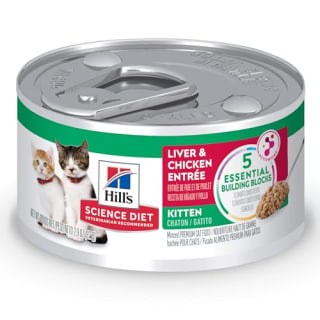
What we like
Multiple flavors availableMultiple sizes availableNatural ingredients
Something to note
Nothing to note at this time
This wet food is available in five protein-rich flavors, so you can experiment with different options until you find the one your kitten likes best. It is made with easily digestible ingredients, as well as vitamins C and E, to support young cats’ immune systems. It also has DHA from fish oil in its formula, plus prebiotic fibers to keep the gut microbiome and digestive system healthy.
Size: 24 2.9 oz. or 5.5 oz. cans | First ingredient: Pork liver | Other flavors: Chicken, roasted chicken and rice, salmon, savory turkey
Best pate: Blue Buffalo Baby Blue Natural Kitten Wet Cat Food
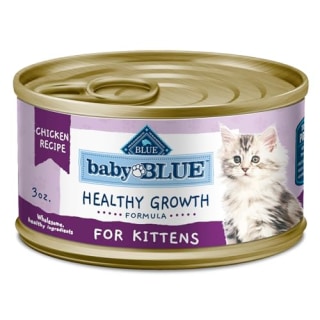
What we like
Free from corn, wheat and soyNatural ingredientsFish oil
Blue Buffalo’s wet kitten food is made with real chicken and does not contain poultry by-products. It’s also free from corn, wheat and soy, as well as artificial flavors and preservatives. The wet food, which has a pate texture, is formulated with fish oil as a source of DHA and natural ingredients like brown rice, flaxseeds, sweet potatoes and carrots.
Size: 6 or 24 3 oz. cans | First ingredient: Chicken | Other flavors: None
How to shop for the best kitten food
AAFCO nutrition standards
The Association of American Feed Control Officials (AAFCO) is a non-profit organization that establishes nutrition standards for pet food and labeling standards for different life stages. Pet food companies formulate and test their products against these standards to ensure they’re “complete and balanced” — this means the food contains necessary nutrients in the correct ratios, according to the AAFCO. The nutrient quantities and ratios necessary for each life stage vary, so the AAFCO’s nutrition standards differ accordingly. For example, growing pets, meaning puppies and kittens, need more calorie-rich food that may cause less active adult animals to become overweight.
That said, make sure the kitten food you buy meets AAFCO nutrition standards. You can determine this by looking at the nutritional adequacy statement on the label. It’s usually in small print on the back or sides of the package. The label should note that the food is “complete and balanced for growth,” meaning designed for kittens only, or “complete and balanced for all life stages,” meaning designed for cats of all ages.
Ingredients
Experts told us that as long as you buy kitten food that meets AAFCO standards, all the ingredients are safe and each serving offers a complete, balanced meal. But if you want to know more about exactly what the food is made from, read the nutrition label with the following in mind.
Protein (ideally 35% to 50%): On a food label, ingredients are listed by weight from highest to lowest. When it comes to kitten food, protein should always be the first ingredient, meaning it makes up the bulk of the recipe, says Hart. Protein is important for kittens to eat at high volumes because it helps ensure proper bone and lean muscle growth.Fats (ideally 18% to 35%): The kitten food you buy should contain some fat, like DHA, an omega-3 fatty acid.Calcium (ideally 0.8% to 1.6%) and phosphorus: Hart says kitten food with sufficient calcium and phosphorus ensures proper bone development. The calcium level is usually higher than the phosphorus level.Other important nutrients: Other important nutrients are vitamin A, which helps with growth, muscle and neurological development, and vitamin E, which supports the immune system, says Hart. Kitten food also needs to have taurine, an amino acid that strengthens the heart and supports healthy blood flow, among other benefits. Fiber, which supports digestive health, is crucial too.
Hart says the protein and fat content in wet kitten food might be falsely low because moisture is accounted for. Your vet can help you determine if a kitten’s food meets the appropriate protein and fat percentages on a dry matter basis, meaning the percentage without accounting for moisture.
Food type
Should kittens eat dry food, wet food or both? This is a common question among cat parents. Ideally, cats, regardless of their age, should eat wet and dry food daily because each type offers different benefits. Loftus says that exposing kittens to wet and dry food early in life can also help reduce food aversions later on.
Wet food is high in water content and helps cats get extra moisture into their diet. This is important since cats don’t naturally drink a lot of water but need it to maintain proper kidney function, says Hart.Dry food typically has more carbohydrates than wet food, and it’s beneficial for cats’ dental health. Its abrasive texture helps scrape plaque and tartar off cats’ teeth as they chew, says Hart. You can also use dry food as cat treats or put it inside puzzle toys, which keeps kittens mentally engaged as they work for food.
How to feed your kitten
Once you’ve picked out wet and dry food, you should determine how much and how often you should feed your kitten. Below, experts share their tips.
How much food do I feed my kitten?
How much food you need to feed your kitten changes as they grow and age, and factors like their breed, growth rate and overall health status contribute. That means there’s no hard-and-fast rule for how much food to feed your kitten, so talk to your vet about what they recommend. The nutrition label on cat food packaging offers serving size guidelines based on cats’ size and weight, a great reference point, says Gonzalez.
How often should I feed my kitten?
Regarding feeding frequency for kittens, you have three options: meal feeding, free feeding and combination feeding.
Meal feeding
Meal feeding involves feeding your kitten a few small meals daily, giving them wet and dry food at specific times to create a consistent schedule. You can experiment with the exact time of feedings to figure out when they tend to get hungry. Kittens ages zero to six months typically need to eat two to three meals a day, but some may require meals every six to eight hours, which could end up being three to four meals a day, says Hart. Starting at six months old, you can just feed your kitten twice a day, says Loftus.
Free feeding
Free feeding involves making food available to your kitten at all times. You can only free-feed dry food, however. You should not leave wet food out for more than four hours because it can grow bacteria and dry out, which may make it less appetizing to your kitten and can deter them from eating it again in the future, says Hart. If you’re free-feeding dry food, discard anything that hasn’t been eaten every 24 hours and replace it with fresh kibble.
The main downside to free-feeding kittens is that it can cause them to gain unhealthy weight early in life, potentially predisposing them to health conditions later on, says Hart. Kitten food is higher in fat and calorie count than adult cat food, so serving them limited portions prevents overeating. But as long as you monitor their body condition to ensure they’re gaining weight appropriately and have an ideal muscle-to-body fat ratio as they reach maturity, free feeding can be a great option for some kittens, experts told us.
Combination feeding
Some kittens are grazers, meaning they don’t like to eat all their food at once and prefer to nibble a little bit at a time, says Loftus. If that’s the case, combination feeding might be their best option. You can free-feed dry food, leaving a measured portion out all day so your kitten can eat whenever they want, and meal-feed wet food, giving your kitten a small portion twice a day at specific times. I’ve always fed my cats this way, and it’s worked very well for both of them. But every cat is different, so pay attention to their eating habits and feed them accordingly.
Frequently asked questions
What’s the difference between cat food and kitten food?
The main difference between cat food and kitten food is the proportion of nutrients each is made with. Kitten food has higher levels of protein, fat, calcium, and phosphorus compared to adult cat food to support young cats’ growth and development, says Loftus. Adult cat food also lacks DHA and other fatty acids that are essential to kittens’ brain and eye development. Because of this, experts told us kittens should not routinely eat adult cat food.
Some cat food is formulated to meet the nutritional needs of kittens and adult cats — it’s labeled cat food for “all life stages.” However, one serving of cat food for all life stages tends to be less calorically dense than one serving of kitten food, which may mean you’ll need to feed your kitten more often.
When should you transition a kitten to adult cat food?
You can usually transition your kitten to adult food when they’re about one year old or when they’ve reached maturity and stopped growing, says Loftus. Some cats reach maturity later than one year old, like Maine Coon cats, which is a large breed. Talk to your vet about what they recommend for your kitten before transitioning.
Loftus recommends changing your cat’s food over a five- to seven-day period or even slower if they have a particularly sensitive stomach. He recommends transitioning a cat’s diet from kitten to adult food in quarters. On day one, feed them 1/4 of the new food and 3/4 of their old food, gradually increasing to 100% of the new food over time.
What should I do if my kitten is a picky eater?
Just like kids, kittens can be picky about their food. While this can certainly be due to general pickiness, it could also be an indicator of illness, says Loftus. So before you try anything else, be sure to have your kitten examined by their vet to rule out parasites or infections that could affect their appetite. If the vet gives your kitten a clean bill of health, you can try a few different strategies to make eating more pleasurable for them.
Ask whoever was taking care of your kitten before you what type of food they were eating when they were weaned from their mother. If a kitten was exposed to a specific flavor, texture or shape of food early in life, they may have formed a preference for it, says Hart. If you can get this information, you can try to find that exact food or something close to it. Offer them different options until you find something they like, and then stick to it, says Gonzalez. Wet and dry kitten food comes in various flavors and textures, so consider experimenting with a few. He says you can also try warming up wet food, which some cats find more appealing. Hart suggests mixing kittens’ food with toppers to entice them, such as low-sodium unseasoned chicken broth, plain scrambled eggs or egg whites. Adjust your kitten’s feeding schedule. Some kittens may prefer to eat multiple small meals throughout the day instead of larger meals in the morning and evening. As long as they eat an appropriate amount of food daily, you can break up servings however they prefer. Change where you’re feeding your kitten in your home. When one of my kittens would not eat, I realized it might be because of a noisy air conditioner near her food bowl. I moved her bowl further away and she ate her food immediately.
Are grain-free diets safe for kittens?
Yes, grain-free diets can be safe for kittens or cats of any age, so long as they’re still eating sufficient levels of carbohydrates, vitamins and minerals, experts told us. “Grain-free” is a claim some brands add to their foods’ labels when made without wheat, barley, rye, corn, millet, rice or oats. Some people think a grain-free diet is healthier for cats because wild cats don’t eat these types of grains, so they believe domestic cats don’t need them either, says Hart. However, grains are an important source of carbohydrates for energy, as well as vitamins and minerals like iron, calcium and vitamin B, which are essential for proper organ function.
Experts told us that if you work with your vet to find a complete and balanced grain-free food, it’s safe for your kitten to eat. “The FDA is still investigating the link between feeding grain-free diets and heart disease in dogs, but no such link appears to exist in cats,” says Hart. “Thus, there does not appear to be a risk in feeding grain-free foods to kittens at this time.”
Are raw food diets safe for kittens?
No, raw food diets are not safe for kittens or cats of any age. All the experts we spoke to recommend against feeding your cat a raw food diet, as does the American Veterinary Medical Association . A raw food diet is centered around ingredients that are not cooked or otherwise heat treated, which some people believe is healthier to feed cats because ingredients are closer to their natural forms, closely mimicking the diet of wild cats, says Hart. But because raw food diets contain uncooked eggs and meat, there’s a high risk of foodborne illness for the cat eating it and the person serving it, says Loftus.
Meet our experts
At NBC Select, we work with experts with specialized knowledge and authority based on relevant training and/or experience. We also ensure that all expert advice and recommendations are made independently and with no undisclosed financial conflicts of interest.
Dr. Hannah Hart is a veterinarian at Chewy.Dr. John Loftus, a board-certified small animal internal medicine specialist and veterinary nutritionist, is an assistant professor of small animal internal medicine and nutrition at Cornell University College of Veterinary Science.Dr. Abel Gonzalez is a veterinarian and the clinical director at Dutch, a pet telehealth company.
Why trust NBC Select?
Zoe Malin is an associate updates editor at NBC Select who writes about pets, including articles on cat carriers, vacuums for pet hair and dog beds. For this article, she interviewed three veterinarians about how to shop for the best kitten food and rounded up options that meet experts’ guidance. Malin also has two cats, and has raised a total of six cats throughout her lifetime. She’s volunteered at animal shelters for over a decade as well.
Catch up on NBC Select’s in-depth coverage of personal finance, tech and tools, wellness and more, and follow us on Facebook, Instagram, Twitter and TikTok to stay up to date.

